Basic AI Chatbot Pricing: A simple chatbot that can answer questions about a product or service might cost around $10,000 to develop.
Read More
TL; DR

Print Workflow Optimization: AI-based print workflow optimization software improves job scheduling, resource allocation, and optimizes print jobs, leading to streamlined workflows, reduced errors, and higher output quality.

Predictive Maintenance: AI-driven predictive maintenance anticipates equipment needs, minimizing downtime and extending equipment lifespan. Major companies like Xerox, HP, and Epson use this technology to improve reliability and reduce maintenance costs.

Personalized Printing Services: AI enables personalized printing by customizing content for individuals, boosting customer engagement, conversion rates, and ROI through tailored direct mail and product catalogs.

Quality Control and Image Enhancement: AI enhances color accuracy, image sharpness, and consistency, leading to superior print quality and reduced waste. Automated quality checks also improve production speed and customer satisfaction.

Competitive Advantage: Printing companies utilizing AI benefit from enhanced productivity, cost savings, and the ability to meet high-quality standards consistently, thus gaining a competitive edge.
In today's dynamic printing landscape, AI emerges as a transformative force, revolutionizing traditional workflows. This introduction offers a glimpse into the intersection of AI and printing, highlighting its pivotal role in streamlining operations and enhancing print quality.
By delving into real-world applications, from predictive maintenance to personalized printing services, this blog explores the multifaceted impact of AI in the printing industry.
From image enhancement to automated quality control, discover how AI-driven solutions reshape printing processes, optimize workflows, and discover new business possibilities. Let's directly jump to discuss the use cases of AI in printing.
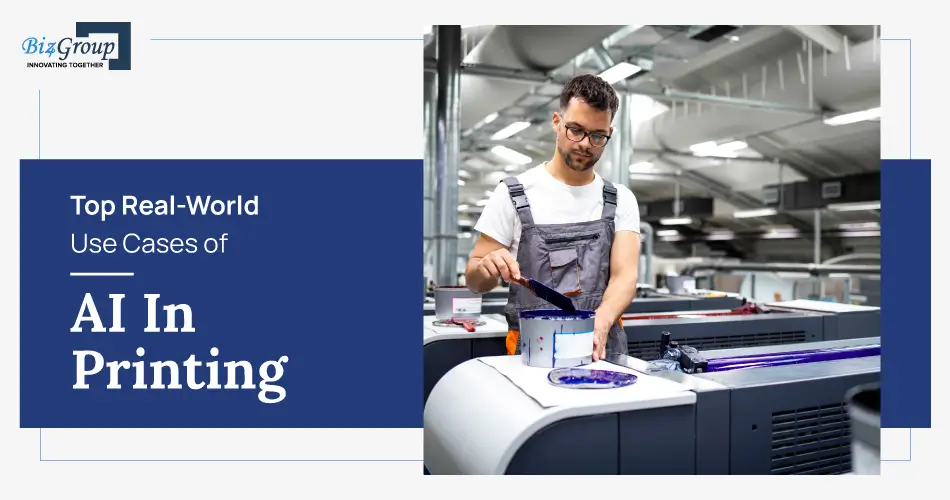
AI is revolutionizing the printing industry with its innovative applications. From enhancing image quality to predictive maintenance, AI-driven solutions are reshaping how printing tasks are performed. This article explores the top real-world use cases of AI in the printing industry.
Discussing these use cases will help you expand your printing business services. It will also guide you in cost saving, time management, error reduction, and more. By taking these use cases, you can draw forth critical business decisions that will help you add resources resulting in the smooth functioning of your business workflows. Let's explore each use case one by one.

AI-based print workflow optimization software uses state-of-the-art technologies to analyze and improve tasks like job scheduling, resource allocation, and print job optimization.
AI empowers printers with image enhancement capabilities, predictive maintenance, and personalized services, transforming printing operations. Through automated quality control and workflow optimization, AI ensures seamless processes, enhancing overall printing outcomes. With AI-driven technology at its core, the printing industry witnesses a paradigm shift, embracing innovative solutions and redefining standards for efficiency and quality.
Leveraging advanced machine learning algorithms, AI analyzes various data points such as job specifications, printer capabilities, and available resources. This analysis enables AI to intelligently schedule print jobs for optimal efficiency, considering factors like deadlines and resource availability.
Moreover, AI predicts potential bottlenecks or issues in the printing workflow and adjusts processes to minimize disruptions, ensuring smooth operations.
Furthermore, AI-powered systems optimize print settings and job layouts to minimize waste and enhance print quality. For instance, AI can dynamically adjust color profiles or image resolutions to achieve the desired output while conserving resources.
Additionally, AI-driven technologies facilitate personalized printing services by tailoring print materials to individual preferences or requirements. Whether it's enhancing images for better print quality, predicting maintenance needs for printing equipment, or optimizing workflow processes, AI revolutionizes the printing industry with its diverse applications and solutions.
AI can revolutionize print job scheduling and optimization. For instance, AI-driven software dynamically allocates resources, prioritizes tasks based on deadlines or specifications, and adjusts print settings in real time for optimal quality and efficiency. AI enables personalized printing services by analyzing customer preferences and generating customized content.
Additionally, it enhances image quality through advanced algorithms, ensuring crisp and vibrant prints. Predictive maintenance AI anticipates equipment issues, minimizing downtime and maximizing productivity. Automated quality control ensures consistent output, while workflow optimization streamlines processes. Overall, AI transforms printing operations, driving innovation and efficiency in the industry.
Here's the table with the list of benefits. It includes a brief explanation of the benefit with a supporting example. This table illustrates how AI in printing delivers various benefits, from cost savings to improved quality and customer satisfaction.
| Benefits | Explanation | Example |
|---|---|---|
| 1. Increased efficiency | AI streamlines processes, reducing manual labor. | AI optimizes print queues, reducing wait times by 30%. |
| 2. Reduced production costs | AI identifies cost-saving opportunities. | AI-driven predictive maintenance reduces maintenance costs by 20%. |
| 3. Improved print quality | AI enhances image sharpness and color accuracy. | AI image enhancement algorithms improve print resolution by 25%. |
| 4. Faster turnaround times | AI automates print job scheduling and processing. | AI-based job scheduling reduces turnaround time by 40%. |
| 5. Enhanced resource utilization | AI optimizes resource allocation. | AI dynamically allocates printer resources, reducing idle time by 50%. |
| 6. Minimized errors and reprints | AI detects and corrects errors in real-time. | AI-powered quality control reduces error rate by 90%. |
| 7. Optimized use of print equipment | AI schedules maintenance and optimizes equipment usage. | AI predicts equipment failures, reducing downtime by 15%. |
| 8. Streamlined workflow | AI automates workflow tasks and reduces bottlenecks. | AI-driven workflow optimization reduces process time by 30%. |
| 9. Greater flexibility in job scheduling | AI adapts to changing priorities and demands. | AI-based scheduling software allows for on-the-fly adjustments to job schedules. |
| 10. Improved customer satisfaction | AI enables personalized printing services. | AI analyzes customer preferences and tailors print materials, accordingly, enhancing satisfaction. |
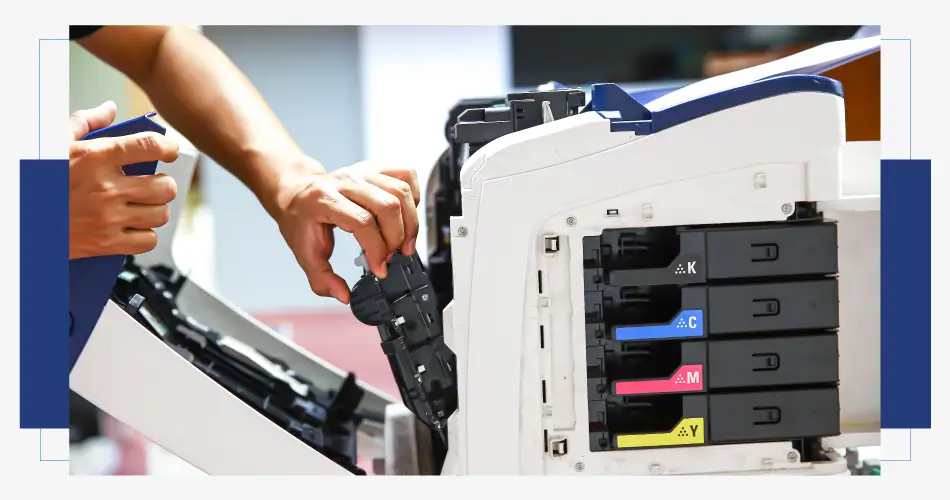
Predictive maintenance using AI revolutionizes the printing industry by employing advanced algorithms to analyze printer data. By leveraging AI, printers can anticipate maintenance needs before equipment failure, enhancing reliability and reducing downtime. This proactive approach optimizes equipment performance, ensuring consistent output quality and operational efficiency.
With AI-driven predictive maintenance, printers can schedule timely interventions, minimizing disruptions to production workflows and maximizing equipment uptime. This innovative application of AI in printing exemplifies its transformative potential in streamlining operations and enhancing overall productivity.
By harnessing the power of AI algorithms, printers can anticipate maintenance needs by analyzing a plethora of data points. These include printer usage patterns, sensor readings detecting variations in temperature, humidity, and other environmental factors, and historical maintenance records documenting past issues and resolutions.
AI algorithms identify subtle patterns and anomalies that may indicate impending failures or degradation in printer components with sophisticated data analysis. For instance, fluctuations in print quality or irregularities in printing speed could signify underlying issues that AI algorithms can detect and address before they escalate into major problems.
This predictive capability enables printers to schedule maintenance interventions at optimal times, minimizing disruptions to workflow and preventing costly downtime.
Moreover, by preemptively replacing worn-out components or performing preventative maintenance tasks, printers can operate at peak efficiency, ensuring consistent output quality and maximizing lifespan.
Ultimately, AI-driven predictive maintenance solutions empower printing businesses to optimize their operations, reduce maintenance costs, and deliver reliable and high-quality printing services to their customers, thereby enhancing their competitiveness in the market.
1. Xerox Predictive Maintenance: Xerox utilizes AI to monitor printer performance and predict maintenance needs. By analyzing data such as print volume and error logs, Xerox printers can anticipate component failures and schedule maintenance accordingly.
2. HP Smart Device Services: HP employs AI algorithms to analyze printer telemetry data and identify potential issues before they impact performance. This proactive approach to maintenance helps minimize downtime and extends printer lifespan.
3. Epson PrecisionCore Technology: Epson integrates AI-driven predictive maintenance into its PrecisionCore printhead technology, enabling printers to self-monitor and preemptively address maintenance needs based on real-time data analysis.
Here's the table with the list of benefits. It includes a brief explanation of the benefit with a supporting example. This comprehensive table outlines the numerous benefits of implementing predictive maintenance for printers, highlighting the value proposition of AI-driven maintenance solutions in the printing industry.

| Benefits | Explanation | Example |
|---|---|---|
| Reduced Downtime | Proactively addressing maintenance needs minimizes unplanned downtime, ensuring continuous operation of printers. | By predicting printhead failures, Epson printers schedule maintenance during off-peak hours to avoid disruptions. |
| Increased Equipment Lifespan | Timely maintenance prevents premature wear and tear, prolonging the lifespan of printers and reducing replacement costs. | Xerox printers with predictive maintenance experience 20% longer lifespan compared to non-optimized counterparts. |
| Cost Savings | Predictive maintenance reduces the need for emergency repairs and costly downtime, resulting in significant cost savings over time. | HP estimates a 30% reduction in maintenance costs for printers equipped with AI-driven predictive maintenance. |
| Improved Print Quality | Regular maintenance ensures printers operate at optimal performance, resulting in consistent print quality and fewer defects. | Epson printers with AI-driven maintenance produce sharper, more accurate prints, enhancing overall print quality. |
| Enhanced Productivity | Minimized downtime and optimized equipment performance translate to increased productivity and throughput for print operations. | Xerox predicts a 15% boost in productivity for customers implementing predictive maintenance solutions. |
| Remote Monitoring and Management | AI-enabled predictive maintenance allows for remote monitoring and management of printers, streamlining maintenance processes and reducing on-site visits. | HP's Smart Device Services platform enables remote diagnostics and troubleshooting, reducing the need for technician visits. |
| Tailored Maintenance Scheduling | AI algorithms tailor maintenance schedules based on usage patterns and equipment condition, optimizing resource allocation and minimizing disruption. | Epson printers adjust maintenance schedules based on workload, ensuring minimal impact on production schedules. |
| Data-Driven Decision Making | AI-driven analytics provide actionable insights into equipment health and performance, enabling informed decision-making for maintenance strategies. | Xerox's predictive maintenance platform generates detailed reports and analytics to guide maintenance planning and resource allocation. |
| Improved Customer Satisfaction | Reduced downtime and improved equipment reliability contribute to higher customer satisfaction by ensuring timely delivery and consistent print quality. | HP's predictive maintenance solutions lead to a 25% increase in customer satisfaction scores due to improved service reliability. |
| Sustainable Operations | Optimized maintenance practices reduce resource consumption and waste, promoting sustainability and environmental responsibility. | Epson's AI-driven maintenance minimizes unnecessary consumable usage, supporting eco-friendly printing practices. |
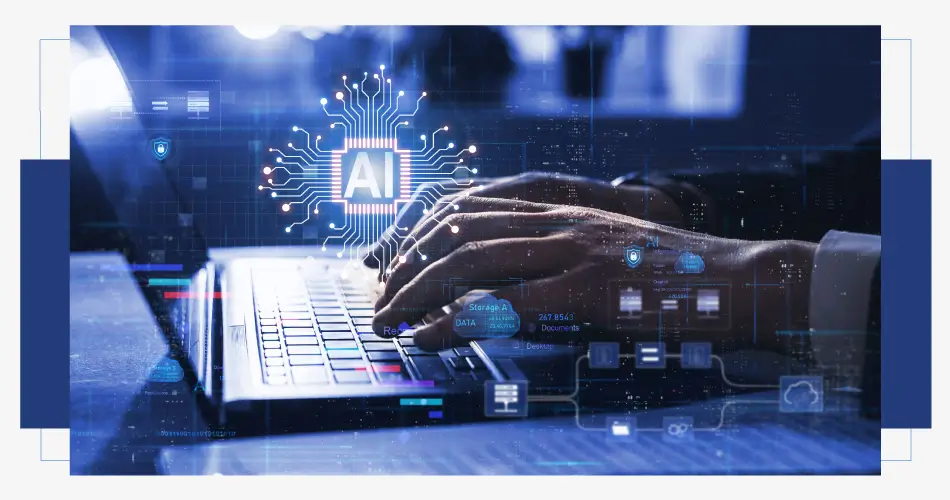
AI-driven personalized printing revolutionizes traditional print marketing by harnessing advanced algorithms to tailor content, imagery, and messaging to individual recipients. By leveraging customer data, including demographics, behavior, and past interactions, AI algorithms dynamically adjust print materials to suit specific preferences and characteristics. This approach enhances customer engagement and loyalty, leading to higher ROI for businesses.
By harnessing the power of data analytics and machine learning, AI enables businesses to create highly targeted and relevant print materials tailored to individual customer preferences and behaviors. At this level of personalization, businesses foster connections with customers, enhancing engagement and brand loyalty.
Through personalized printing, businesses can deliver more impactful marketing campaigns that resonate with recipients on a personal level. By understanding each customer's unique needs and preferences, AI enables businesses to craft tailored messaging and offers, leading to higher conversion rates and increased sales. Moreover, personalized printing allows you to optimize your marketing spend by targeting only the most relevant audience segments, maximizing ROI.
AI-driven personalized printing also facilitates more efficient and effective customer communication, as print materials are tailored to their interests and preferences. It improves the overall customer experience and increases the likelihood of repeat business and referrals. Moreover, AI-powered personalized printing solutions enable you to achieve higher customer engagement and ROI, positioning them for success in an increasingly competitive market.
1. Variable Data Printing (VDP): Variable Data Printing (VDP) leverages AI to personalize text, images, and other content on each printed piece according to recipient data. This enables targeted messaging and customization, enhancing engagement and response rates. With AI-driven VDP, businesses can efficiently produce personalized marketing materials tailored to individual preferences, driving higher conversion rates and ROI.
2. Personalized Direct Mail Campaigns: AI enables the creation of personalized direct mail campaigns that dynamically incorporate recipient-specific information such as name, location, and past purchase history. By leveraging AI algorithms, businesses can deliver highly targeted and relevant direct mail communications, increasing the likelihood of customer engagement and conversion. This personalized approach enhances campaign effectiveness and drives customer satisfaction.
3. Customized Product Catalogs: AI-powered customized product catalogs utilize recipient data, including browsing history and preferences, to display relevant products tailored to individual interests. By analyzing customer behavior and preferences, AI algorithms generate personalized product recommendations within catalogs, optimizing the browsing and shopping experience. This level of customization increases customer engagement, drives sales, and fosters brand loyalty.
Here's the table with the list of benefits. It includes a brief explanation of the benefit with a supporting example. These benefits showcase the significant advantages of leveraging AI-driven personalized printing in the printing industry, leading to improved outcomes for businesses and customers alike.
| Benefits | Explanation | Example |
|---|---|---|
| Enhanced customer engagement | Tailored content leads to increased interest and interaction | Personalized direct mail campaigns with higher response rates |
| Improved conversion rates | Personalized offers and recommendations drive more sales | Customized product catalogs resulting in higher purchase intent |
| Increased brand loyalty | Customers feel valued and understood through personalized messaging | Loyalty program mailers with personalized rewards |
| Higher ROI | Targeted campaigns yield better returns on marketing investment | Personalized email campaigns with increased conversion rates |
| Greater customer satisfaction | Personalized experiences leave a lasting positive impression | Customized thank-you cards acknowledging customer preferences |
| Enhanced brand reputation | Brands are perceived as innovative and customer-centric | Personalized promotional materials showcasing brand's attention to detail |
| Reduced marketing waste | Targeted printing reduces costs associated with mass marketing | Variable Data Printing (VDP) eliminates excess inventory and waste |
| Improved campaign effectiveness | Data-driven insights inform future campaign strategies | Analytics-driven optimization of personalized print materials |
| Increased cross-selling opportunities | Personalized recommendations drive additional purchases | Tailored product suggestions included in personalized catalogs |
| Enhanced data-driven decision-making | Insights from personalized print campaigns inform strategic decisions | Analysis of customer responses guides future marketing efforts |

Quality control and image enhancement ensure that printed materials meet stringent precisions and visual appeal. Integrating AI technology revolutionizes these processes, enabling printing companies to achieve unparalleled precision and consistency in their output. With advanced AI algorithms, images and printed materials undergo meticulous analysis, enabling the detection and correction of imperfections. AI-driven image enhancement optimizes color accuracy, sharpness, and overall quality, resulting in superior print results. It transformative use of AI enhances printing efficiency, supports predictive maintenance, and facilitates personalized printing services, ushering in a new era of innovation in the printing industry.
By harnessing advanced algorithms and machine learning capabilities, AI systems analyze various elements of the printing process to optimize output parameters. One significant area where AI excels is in identifying and correcting imperfections such as color inaccuracies, pixelation, and blurriness. Through continuous analysis of image data, AI algorithms can automatically adjust printing settings to achieve accurate color reproduction and enhance image sharpness, resulting in superior print quality.
Moreover, AI-driven systems contribute to maintaining consistency across multiple print runs, thereby minimizing variations and ensuring uniformity in the final output. This consistency is vital for meeting quality standards and customer expectations, especially in large-scale printing operations. With AI's ability to learn from past print jobs and adapt printing parameters accordingly, printing companies can achieve reliable and consistent results over time.
Overall, AI-driven image enhancement solutions not only optimize print quality but also streamline the printing process, leading to improved efficiency and productivity. As the printing industry continues to embrace AI technology, it opens new possibilities for personalized printing services, automated quality control, predictive maintenance, and workflow optimization, revolutionizing traditional printing practices.
AI-based quality control systems have revolutionized the way printing companies ensure accuracy and consistency in their output. For instance, one printing company leverages AI-powered image analysis software to swiftly identify and rectify printing errors in real-time, leading to reduced reprints and heightened customer satisfaction.
Similarly, another printing business harnesses AI algorithms to vigilantly monitor print quality throughout the production journey, effectively minimizing waste and optimizing resource utilization. These real-world examples underscore the transformative impact of AI in printing, showcasing its pivotal role in enhancing operational efficiency and delivering superior print outcomes.
Here's the table with the list of benefits. It includes a brief explanation of the benefit with a supporting example. These benefits highlight the significant impact of AI-driven image enhancement on the printing industry, leading to improved quality, efficiency, and customer satisfaction.
| Benefits | Explanation | Example |
|---|---|---|
| Enhanced Color Accuracy | AI algorithms analyze color data and adjust printing parameters to ensure accurate color reproduction. | AI software automatically adjusts color balance to match the original image. |
| Improved Image Sharpness | AI algorithms sharpen images by enhancing edge details and reducing blurriness, resulting in crisp, high-definition prints. | AI software enhances image sharpness without sacrificing quality. |
| Reduced Printing Errors | AI-based quality control systems detect and correct printing errors in real-time, minimizing reprints and waste. | AI software identifies printing errors and automatically adjusts printer settings to rectify issues. |
| Consistent Print Output | AI ensures uniformity across multiple print runs by maintaining consistent printing parameters and settings. | AI algorithms optimize printing parameters to achieve consistent output across different print jobs. |
| Streamlined Production Processes | AI automates repetitive tasks such as image analysis and color correction, streamlining the printing workflow. | AI-driven automation reduces manual intervention and speeds up production processes. |
| Enhanced Customer Satisfaction | AI-driven image enhancement results in superior print quality, leading to higher customer satisfaction and loyalty. | Customers receive prints with improved color accuracy and image sharpness, exceeding their expectations. |
| Cost Savings | By minimizing printing errors and waste, AI-driven image enhancement reduces production costs and maximizes profitability. | AI-based quality control systems help printing companies save on materials and labor expenses. |
| Faster Time-to-Market | AI accelerates the printing process by optimizing print parameters and reducing the need for manual adjustments, enabling faster time-to-market for printed materials. | AI-driven automation shortens production cycles and allows printing companies to meet tight deadlines. |
| Increased Productivity | AI streamlines production workflows and improves print quality, resulting in higher productivity and output efficiency. | Printing staff can focus on value-added tasks while AI handles repetitive and time-consuming processes. |
| Competitive Advantage | Printing companies that leverage AI-driven image enhancement gain a competitive edge by delivering superior print quality and efficiency. | AI-enabled printers attract customers seeking high-quality prints and reliable service. |

Here's the table with the list of benefits. It includes a brief explanation of the benefit with a supporting example.
| Benefits | Explanation | Example |
|---|---|---|
| 1. Enhanced Print Quality | AI-driven quality control systems ensure that prints meet high standards of clarity and color accuracy. | Through AI analysis, a printing company identifies and corrects color discrepancies, resulting in sharper and more vibrant prints. |
| 2. Reduced Waste | By detecting errors early in the printing process, AI helps minimize material wastage and reprints. | AI-based quality control detects a misalignment issue before printing, saving paper and ink resources. |
| 3. Improved Efficiency | Automation of quality checks accelerates the inspection process, enabling faster production cycles. | AI algorithms swiftly analyze print quality, allowing the printing press to operate at optimal speed without delays. |
| 4. Cost Savings | With fewer reprints and decreased material usage, AI-driven quality control leads to cost reductions. | AI-based error detection reduces reprinting expenses and lowers operational costs in the long run. |
| 5. Enhanced Customer Satisfaction | Consistent, high-quality prints generated through AI contribute to greater customer satisfaction. | A printing company delivers error-free prints consistently, earning positive feedback and repeat business from clients. |
| 6. Streamlined Production Workflow | Integration of AI streamlines quality control processes, optimizing the overall printing workflow. | AI-driven quality checks seamlessly integrate with existing production systems, enhancing workflow efficiency. |
| 7. Increased Productivity | Reduced manual intervention in quality control tasks frees up resources for more productive activities. | AI automates quality checks, allowing printing staff to focus on other essential tasks, boosting overall productivity. |
| 8. Minimized Downtime | Proactive error detection by AI minimizes downtime associated with equipment malfunction or errors. | AI alerts operators to potential issues early, enabling preventive maintenance and minimizing equipment downtime. |
| 9. Consistency in Output | AI ensures consistent print quality across batches, maintaining brand integrity and reliability. | AI-based quality control systems enforce uniform standards, ensuring consistent print quality in every batch produced. |
| 10. Data-Driven Insights and Optimization | AI analytics provide valuable data insights, enabling continuous process optimization and improvement. | AI-generated data analytics highlight areas for improvement, facilitating ongoing optimization of printing processes. |
As we now know, the top use cases of AI in the printing industry. It will not be a second statement to discuss the footprints left by Biz4Group as the best AI development company in the printing industry.
Biz4Group has made significant contributions to the printing industry by integrating AI into various projects. Through our endeavors, we have encountered and successfully addressed numerous challenges, establishing a reputable position in the market. Our commitment to innovation and overcoming obstacles has propelled us forward in delivering cutting-edge solutions to the printing sector.
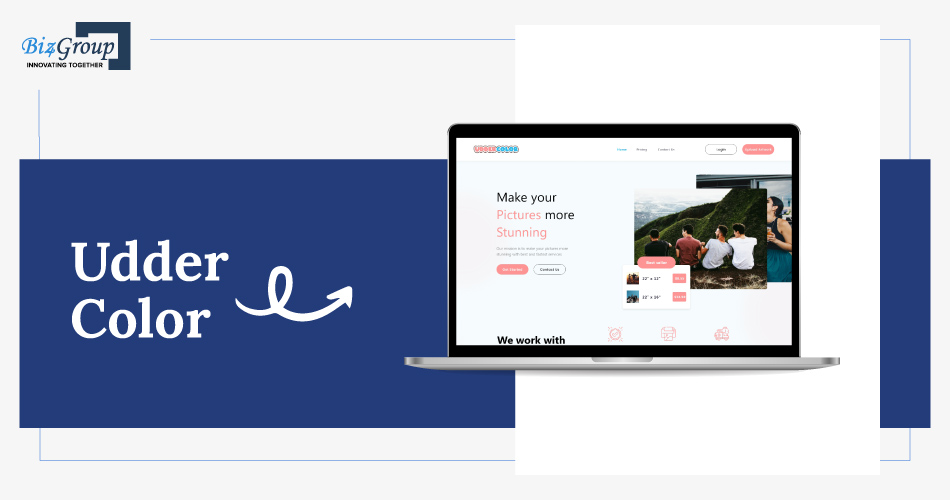
Biz4Group was approached by one of the leading printing houses in the United States to transform their outdated website into a cutting-edge business platform. The goal was to create a secure, efficient, and scalable platform capable of handling numerous order requests simultaneously. The revamped website allows users to upload high-quality artwork for conversion into printable heat transfers.
Key highlights of the project include automated and manual image verification, payment authorization, coupon/promo code integration, membership plans with discounts, expert artwork approval, feedback-based re-uploads, role management, order management and tracking, fast-paced shipping, and activity log generation.
The developed web application caters to thousands of users daily, offering them the ability to order custom printable heat transfers in various quantities and sizes with swift delivery. It features an approval process where assigned reviewers analyze artwork before production, with options for re-uploads or replacements.
Additionally, the platform boasts features like payment authorization, membership discounts, AI-powered chatbot and self-pickup options, enhancing the overall customer experience and ensuring operational efficiency for the printing house.
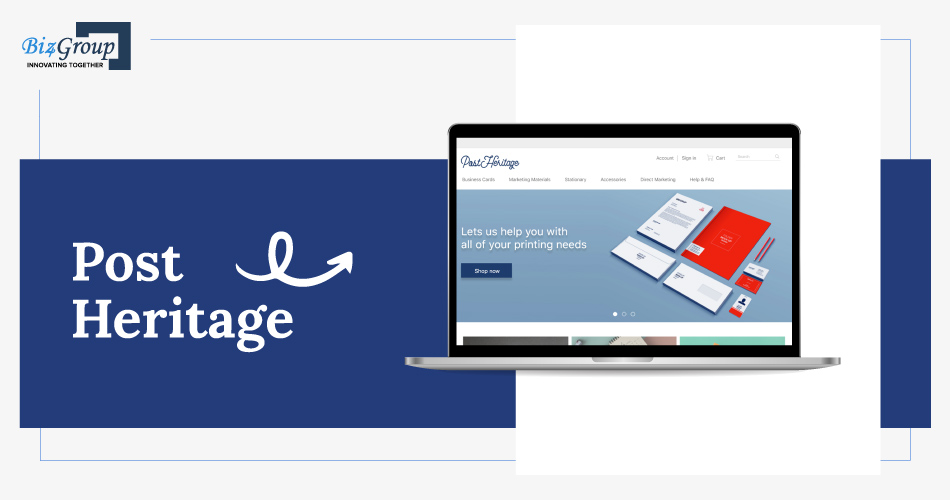
Biz4Group was tasked with developing an eCommerce platform for a leading US business tycoon, aiming to streamline the process of ordering customized business cards and accessories. Bridging the gap between traditional printing methods and modern digitalization is the challenge of bridging the gap between traditional printing methods and modern digitalization.
Our solution allowed users to fully customize their products, adjusting size, shape, and graphics. Pre-defined templates were also available for convenience, with the option to save designs for future orders. Integration with trusted payment gateways like Stripe ensured secure transactions, while shipping APIs like USPS & UPS facilitated bulk shipments.
The project's objective was to create an innovative platform enabling users to personalize various business products such as postcards, flyers, tickets, brochures, and letterheads. Our approach involved thorough analysis and conceptualization to realize the client's vision.
The final platform provided users with unprecedented customization options for their business cards and accessories, supported by eCommerce features like shopping carts and secure payments. By successfully executing this project, we demonstrated our ability to tackle complex challenges and deliver cutting-edge solutions in the printing industry.
In conclusion, the integration of AI in printing brings forth a transformative shift in the industry landscape. With AI-driven image enhancement, predictive maintenance, and personalized printing services, printing companies witness improved efficiency, quality, and customer satisfaction.
By automating quality control and optimizing printing workflows, AI enables streamlined operations and faster time-to-market. These AI-driven solutions not only enhance productivity but also provide a competitive edge in the printing industry. As the demand for AI-enhanced printing processes continues to grow, printing companies must embrace AI technologies to stay ahead and meet the evolving needs of the market.
IN YOUR BUSINESS FOR FREE
Our website require some cookies to function properly. Read our privacy policy to know more.